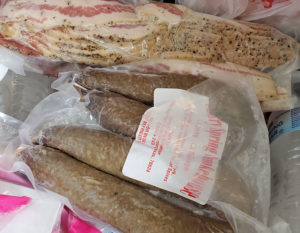 Feb 22, 2023–A native Texan who worked one summer for a farmer in Iowa was describing the experience:
Feb 22, 2023–A native Texan who worked one summer for a farmer in Iowa was describing the experience:
“I’d help during the soybean harvest. At noon, his wife would drive out into the field in the family station wagon, open the tailgate, and there would be a full course dinner, served on good china!”
Oh, the memories that brought back. Being a teenager baling hay and pulling weeds. Those midday meals–yes, called “dinner,” not lunch–when we effortlessly wolfed down piles of fried chicken, bowls of mashed potatoes, always gravy and butter, green beans from the garden, slices of bread with jelly, with thick apple pie for dessert, and crocks of cold lemonade or tea.
We ate every bite. And that was after a midmorning snack of ham and cheese sandwiches, chips, and cokes, followed by a midafternoon snack of more sandwiches, plus cookies or leftover slices of pie.
Then we went home, where mom had a roast with all the sides waiting on the table.
Eating as a teen on the farm was an ongoing quest for food. Our day started with an early breakfast of thick-sliced bacon fried in a cast iron skillet. As the bacon drained on a paper towel, mom cracked eggs into the hot pan, flipping the grease over the eggs with her spatula so they would cook on top. Meanwhile, we sawed thick slices of homemade bread to toast, then slathered them with homemade apple butter, washed down with a large glass of cold milk.
We ate like that every day, yet you didn’t see many fat farm teens.
It was real food. Like most families, we had a garden the size of a small east European nation. At harvest time, our family would rotate among the aunts and uncles to help pick, snap, and can endless jars of beans, and snub and freeze seas of berries.
Meal preparation was a feast of the senses, not all savory. I retain distinct memories of mom plucking a chicken, then holding it by its legs in the middle of the kitchen while she passed a flaming rolled-up newspaper under it to singe off the pin feathers. Then she carried it to the sink, where she expertly disemboweled it and cut it up, dipping it in egg and flour before frying it up in a hot skillet, along with the liver, gizzard, heart, and neck.
We always raised our own beef, too. Dad would pick out a steer to fatten. At butchering time, it went to the local locker plant, where it was carved up and frozen. In the 1950s, most households rented a locker at the butchers, where you stored your meat. When you needed it, you would run to town and bring home the packages, wrapped in that brown waxed paper, neatly labeled with the cut.
As a kid, we knew it was time to butcher another steer when mom served the oxtail, tongue, and heart. This may be hard to believe for Texans, but the absolute last cut used was this thing called the brisket. Invariably mom would boil it in a stew, and we would have to gnaw through the gristly, tasteless slab of meat.
When my future Texas wife’s family invited me over for brisket, I assumed they couldn’t afford real meat. Then I tasted it. It was a revelation that a cut so lowly could ascend to such gustatory heights when prepared with smoke and fire.
Sorry, Iowa. You do many foods well, but you’ll never beat Texas brisket.